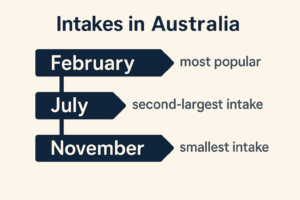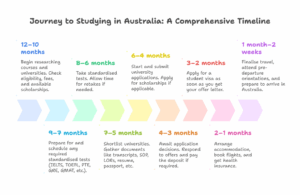
Intakes in Australia 2025: Timeline, Application Deadlines
If you’re an international student looking to study in Australia, understanding the multiple intakes in Australia is crucial. Australia has three main intakes for international students: February, July, and November. Whether you’re considering undergraduate programs, postgraduate studies, or professional diplomas, the timing of your application will significantly affect your course options and scholarship opportunities.
In this article, you’ll find everything you need to know about Australia intakes, application deadlines, and how to choose the best intake for yourself.
Intakes in Australia
Australia is known globally for its education system, welcoming students from all over the world, including a large community of Indian students. The country’s universities typically offer three main intakes each year: February, July, and November. These are often referred to as the February intake (main/semester 1), the July intake (mid-year/semester 2), and the November intake (semester 3).

Each intake in Australia comes with its own set of application deadlines, available courses, and university-specific arrangements. Some institutions may even offer additional, specialised intakes, but for most students, these three windows represent the main opportunities to start their studies in Australia.
February Intake in Australia: The Primary Intake
The February intake in Australia, also called the ‘semester 1’ or main intake, is the largest and most popular among international students. If you are seeking the broadest selection of courses and universities, the February intake in Australia is your starting point. Choosing the February intake provides a competitive academic and social edge, as you’ll enter alongside the majority of your peers and have access to every course offered for the full academic year.
Key Features of the February Intake
- Widest Course Availability: All major universities participate, offering extensive undergraduate, postgraduate, and diploma programs.
- Academic Year Start: Aligns with the beginning of the Australian academic calendar, maximising campus life, events, and academic support.
- Peak Admissions Window: Most students begin their studies during this period, fostering a vibrant, international cohort.
Top Universities Open for February Intake
Many of Australia’s highest-ranked universities participate in this intake, including:
- University of Melbourne
- University of Sydney
- Australian National University
- University of Queensland
- University of New England
- University of Canberra
- Macquarie University
- University of Wollongong
February Intake 2026 Deadline and Duration
| Aspect | Dates |
| Application Deadline | July 2025–November 2025 |
| Application Opens | July 2025 |
| Application Closes | November–December 2025 |
| Classes Commence | Late January–Early February 2026 |
| Semester Ends | May–June 2026 |
July Intake in Australia: The Secondary Intake
The July intake in Australia serves as a secondary, mid-year opportunity for students who may have missed the main intake window or prefer to begin their studies later in the year. Students who opt for the July intake often enjoy a balanced workload and can take advantage of mid-year scholarships and unique academic programs.
Key Features of the July Intake
- Mid-Year Start: Often called semester 2, this intake runs from late July or early August through November.
- Flexibility: A fantastic option for students who need more time for preparation, visa processing, or scholarship applications.
- Not as Competitive: Generally sees fewer applicants, which can translate to more individualised attention and easier accommodation access.
Top Universities for the July Intake
A range of top institutions participate, including:
- University of Melbourne
- University of Sydney
- Australian National University
- University of Adelaide
- University of New South Wales
- RMIT University
- University of Queensland
July Intake 2025 Deadline and Duration
| Aspect | Dates |
| Application Deadline | April–May 2025 |
| Application Opens | February 2025 |
| Application Closes | April–May 2025 |
| Classes Commence | Late June–Early July 2025 |
| Semester Ends | November–December 2025 |
November Intake in Australia: A Limited Intake
The November intake in Australia, sometimes known as the summer or late/spring intake, is the smallest and most specialised among the three. This intake is best suited for those seeking niche programs, vocational pathways, or those who need an expedited study start
Key Features of the November Intake
- Limited Course Choices: Primarily focused on vocational courses, diploma programs, and select postgraduate degrees.
- Ideal for Late Applicants: A great choice for students who missed earlier deadlines or want to start their studies over the Australian summer.
- Personalised Learning: Smaller class sizes, easier campus adjustment, and less crowded housing.
Top Universities for November Intake
Not all universities offer this intake, but some well-regarded options include:
- University of Western Australia
- University of Technology Sydney
- Queensland University of Technology
- University of Wollongong
- Deakin University
- Curtin University
- Monash University
November Intake 2025 Deadline and Duration
| Aspect | Dates |
| Application Deadline | August–September 2025 |
| Application Opens | July–August 2025 |
| Application Closes | September–October 2025 |
| Classes Commence | Early November 2025 |
| Semester Ends | February 2026 |
How to Choose the Right Australian Intake as an Indian Student?
Deciding on the right intake in Australia can make all the difference in your academic experience. Here are the critical factors to consider, especially if you’re an Indian student:
- Your Chosen Program: Not all intakes offer every course. The February intake provides the most comprehensive selection, while July and November may limit your options to specific subjects or programs.
- Application Timeline and Exams: Consider when you’ll receive your current academic results, when you can take necessary global English proficiency or aptitude exams (like IELTS, TOEFL, or GRE), and how long you’ll need for visa processing.
- Personal Preferences: Some students prefer arriving during the Australian summer (February or November), while others favour a mid-year start (July). Consider how weather, travel, holidays, and family commitments affect your timing.
- Financial and Scholarship Considerations: Many scholarships or financial aid opportunities are aligned with the February or July intakes, so research funding options well ahead of your application date.
- Job Market and Post-Study Options: Aligning your graduation date with hiring cycles can enhance your job prospects after finishing your studies.
Timeline to Prepare Yourself Before Intakes in Australia
Here’s a general timeline for planning your studies before any intake in Australia, formatted in a clear table. This generic framework applies regardless of whether you’re aiming for February, July, or November intakes, and it helps ensure nothing is missed in your preparations:
| Months Before Intake | Action to Complete |
| 12–10 months | Begin researching courses and universities. Check eligibility, fees, and available scholarships. |
| 9–7 months | Prepare for and schedule any required standardised tests (IELTS, TOEFL, PTE, GRE, GMAT, etc.). |
| 8–6 months | Take standardised tests. Allow time for retakes if needed. |
| 7–5 months | Shortlist universities. Gather documents like transcripts, SOP, LORs, resume, passport, etc. |
| 6–4 months | Start and submit university applications. Apply for scholarships if applicable. |
| 4–3 months | Await application decisions. Respond to offers and pay the deposit if required. |
| 3–2 months | Apply for a student visa as soon as you get your offer letter. |
| 2–1 months | Arrange accommodation, book flights, and get health insurance. |
| 1 month–2 weeks | Finalise travel, attend pre-departure orientations, and prepare to arrive in Australia. |

Also read: How to Prepare for the Genuine Student Test?
Common Mistakes When Applying to Australian Universities
While planning your Australia intake for 2025, avoid these common pitfalls:
- Missing Deadlines: Application periods are strictly enforced. Late submissions often aren’t considered.
- Focusing on Only Popular Universities: Many students apply only to highly ranked institutions. Broaden your search for better chances of acceptance.
- Neglecting English Proficiency Tests: Not leaving enough time for IELTS/TOEFL rehearsals or retakes can be costly.
- Ignoring Course Availability: Some programs are available only during certain intakes in Australia; check each course’s intake schedule.
- Inadequate Visa Planning: Visa applications require substantial documentation and processing time, start as soon as possible.
- Incomplete Applications: Double-check every requirement, and ensure you include all necessary documents.
How The WorldGrad Can Help?
Navigating intakes in Australia can feel overwhelming, but expert support can simplify each step. Our Global Year 1 and Global Online Accelerator Programs allow students to complete their first term/year studies in their home country and then move to the Australian university campus to complete the rest of their degree studies. Through this approach, they save time and money.
The WorldGrad also specialises in helping students with:
- Personalised Counselling: Identify the best course and intake for your profile and ambitions.
- End-to-End Application Support: Get detailed help with document preparation, deadlines, and SOP/LOR writing.
- Scholarship Assistance: Learn about all available scholarships and optimise your application.
- Visa and Pre-Departure Support: Expert guidance on the visa process, accommodation, travel, and bridging cultural gaps.
Final Thoughts
With three major intakes in Australia—February, July, and November—Australian universities offer flexible pathways for all aspiring students. Plan ahead, meet your deadlines, and don’t hesitate to seek advice or counselling to ensure you make the most of your opportunity to study in Australia in 2025. Whether you’re eyeing the February intake, the July intake, or the November intake, a bright academic future awaits!
Intakes in Australia FAQs
Q1. How many intakes are there in Australia?
A1. There are three major intakes in Australia: February, July, and November. Some universities may have additional intakes or rolling admissions for certain courses.
Q2. Which intake is best for international students?
A2. The February intake is the best and most popular among international students, offering the widest course options and scholarship availability.
Q3. Is there a September intake in Australia?
A3. No, there is no dedicated September intake in Australia. However, a few specialised programs might have start dates close to September.
Q4. Can I apply for more than one intake?
A4. Yes, you can apply for multiple intakes and courses to maximise your chances. However, ensure all applications meet each intake’s deadlines.
Q5. What is the advantage of the November intake in Australia?
A5. The November intake in Australia is ideal for students targeting vocational courses, those looking for smaller class sizes, or those who missed out on earlier deadlines.

